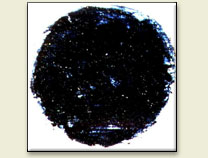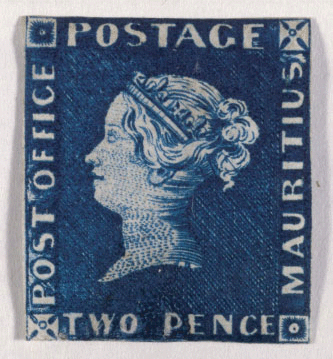
Brief description of Prussian blue:
Dark blue, called the first of the modern pigments. It has very high tinting strength but is only fairly permanent to light and air. It's an Iron-hexacyanoferrate accidentally formed while experimenting with the oxidation of iron. The pigment was available to artists by 1724 and was extremely popular throghout the three centuries since its discovery.
Names for Prussian blue:
| Alternative names: | Milori blue, iron blue, Berlin blue | ||||||
| Non-English names: |
|
||||||
| Origin: | artificial | ||||||
| Chemical name: | Iron(III)-hexacyanoferrate(II) |
Example of use by artists:
Million pounds ink

Unused deep blue 2 pence Mauritian stamps of 1847, British Library
In 1847, Mauritius became the first British Colony and the fifth country in the world, along with the USA, to issue
postage stamps. The postal system, which had previously existed under French rule, was reorganised and the Post
Office Ordinance was passed, which led to the introduction of stamps in denominations of one penny for letters
posted at the central post office for delivery in Port Louis, and two pence for delivery elsewhere on the island.
Only 12 examples of the 1847 2 pence stamp are known still to exist. One unused 1847 2 pence stamp is held at the British Library as a part of the Tapling Collection. The rarity and hence great value of these Mauritian stamps, the rarest realising up to about £1 million at auction, is such that they are often known as the ‘Crown Jewels of
Philately’.
A rare 1847 2 pence deep blue unused stamp was analysed using Raman microscopy in order to determine the identities of the pigments on the stamps. That in the printing ink was identified as Prussian blue plus the presence of crystals of ultramarine blue dispersed between the paper fibres.
(intro) - Azurite - Cerulean Blue - Cobalt blue - Egyptian blue - Prussian blue - Smalt - Ultramarine

